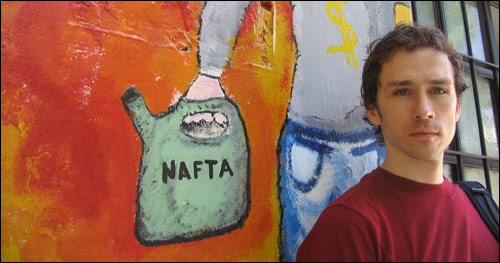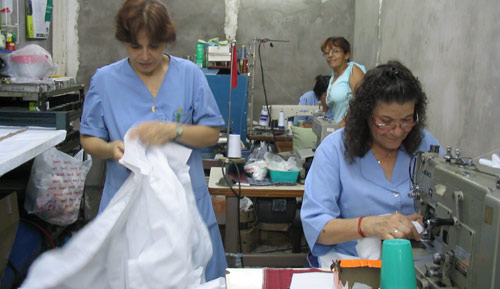Este artículo también está disponible en: Español
June 2006
- Martin in Buenos Aires, in front of one the factories he was helping in January 2006. (Photos: Diego Graglia)
The fall of 2004 had just started when, in a darkened movie theater on Houston Street, Brendan Martin’s life was changed forever.
By the time winter arrived in the city, he would be gone.
A partner at a Wall Street financial information company, Martin moved 5,000 miles south of his Morningside Heights home because of what he saw on screen that evening.
The movie was The Take, a poignant documentary and anti-neoliberalism manifesto about the dozens of worker-controlled factories that had sprung up in Argentina after the country’s economy collapsed in December 2001. Many businessmen had shut down their companies, hoping to pay off debt by selling the machinery. But groups of workers entered the dormant buildings and went back to work, hoping sympathetic judges and lawmakers would later lend legitimacy to their risky move.
When the movie ended, Martin met its director, Canadian activist-journalist Avi Lewis. (Naomi Klein, the renowned author of No Logo, is the film’s screenwriter.) Martin asked him what he could do to help the struggling Argentinean workers.
What they badly needed, Lewis told him, was loans, money they could put to work.
The Ceres shirt factory sits on a tree-lined block in the quiet neighborhood of La Paternal in Buenos Aires. Ceres is one of the over 160 so-called recovered factories and worker cooperatives now functioning in Argentina. Low-end estimates say they employ about 10,000 people. Martin, a 32-year-old with a boyish face, arrived in the factory one sunny summer morning this January, wearing jeans and a burgundy T-shirt and carrying a black backpack. He wanted to show the workers some new label designs his nonprofit, The Working World (TWW), was helping them create.
Martin has been living in Buenos Aires for over a year, and this shows in his Spanish, which he comfortably speaks in the loud, Italian-tinged local accent. “It’s important, because it’s going to be your name,” he said of the new labels to Celina Báez, a 48-year-old seamstress born in Paraguay. She was sewing pockets onto uniform shirts for a major bus company. The fabric for this order had been bought with a TWW loan of about $660.
“We have work, but we’d like to be able to expand a little more,” says Marcela Regueira, 43, president of the cooperative’s 11 workers.
Since December 2004, The Working World has given more than 20 loans to a dozen cooperatives and recovered factories, which used them to buy raw material, improve infrastructure or repair or acquire machines. In the case of the recovered industrial metal factory Crometal, access to working capital has been key. Until TWW gave this cooperative three consecutive loans totaling $29,000, it had been forced to await payment for one order before being able to buy material for the next one.
“Usually, these loans are just not available to people,” Martin says. Unlike banks, TWW does not ask for collateral. “We have no guarantee,” he says, “except goodwill.”
The money comes from a fund Martin set up, which so far has raised about $120,000. According to Martin, this includes private and union donations and also donations and ticket proceeds from The Take screenings. (Lewis, the filmmaker, is TWW’s cofounder and international promoter). Martin put in about $55,000 from his own savings, he says. “Right now, we’re losing money,” he says, but adds that TWW should support itself starting next year. He hopes to then save money to open up shop in some other country.
The loans’ interest rate is 10% – literally a losing proposition, since inflation was 12% in Argentina in 2005.
Among the loans’ recipients are balloon, glassware, shoe, sneaker and auto parts factories. A cooperative of cartoneros –garbage scavengers who became an all-too common sight in Buenos Aires after the collapse– borrowed money to rent a plastic mill to do its own recycling.
“The government doesn’t help us at all. We’ve been asking for a grant, but it didn’t come,” says Alicia Pérez, of the shoe factory Cooperativa Unidos por el Calzado. “The fund loaned us $10,000 to market our brand.”
For Martin, the loans’ success is measured against a “double bottom line”: their social impact –the workers’ welfare and the creation of jobs— is as important as their being repaid.
If a cooperative struggles to come up with the money, Martin says, TWW’s approach is to help the workers solve whatever problems they are facing. Liquidation is a last resort and it involves only the assets acquired through the loan. “We believe the responsibility for a loan is both the borrower’s and the lender’s,” Martin says.
In addition to the loans, Martin recently created market.theworkingworld.org, where products made by the Argentinean cooperatives are sold to U.S. consumers. There, a pair of thick-soled leather shoes made at the Desde el Pie cooperative goes for $57, including shipping.
The website aims to bring money to the workers and contribute to the fund while challenging the global marketing model imposed by multinationals. “In a running shoe, most of the money goes to the brand and little to the makers,” Martin says, adding that his goal is to “put the producer and consumer again in the middle, trying to undercut the position of the brands.”
While his day job is changing the world one microloan at a time, in his off-hours Martin still does consulting work for the financial information company he cofounded. “I still need to make a living,” he says.
Born in Washington D.C. and raised in Rochester, Martin became attracted to cooperative economy while in college at Wesleyan. By the time he saw The Take, he had been thinking of leaving New York to work at “a microcredit bank in Bangladesh or do something in Latin America.
“It fell in place,” he says of the movie.
More than a year and a half after that evening at the movies, Martin’s life is completely different. He comfortably hops on trains to bleak post-industrial outskirts where upper-class porteños normally do not set foot. He drives a Torino, a ’60s era nationally designed car that is the pride of Argentinean blue-collar motor nuts. He plays football – the one where touching the ball with your hand is a foul. And he has an Argentinean girlfriend.
Martin was in New York for Christmas when we first met at the restaurant La Rosita in Morningside Heights. He proudly showed off a pair of rugged black boots from Desde el Pie and, for two hours, talked nonstop about his enterprise. At one point, I asked him what all of this meant to him.
“My whole life is changed,” he said. “I feel it’s opened up to what I’ve always wanted to do.
“It’s the best thing I’ve done in my life.”
 Every-Night Fever at the Milonga (2007)
Every-Night Fever at the Milonga (2007)  Migrants Suffer in Mexico (2006)
Migrants Suffer in Mexico (2006)  Leaving Wall Street (2006)
Leaving Wall Street (2006)  Torn Up Over Being Torn Down (2004)
Torn Up Over Being Torn Down (2004) 



